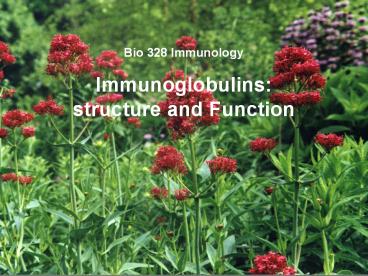Bio 328 Immunology PowerPoint PPT Presentation
1 / 64
Title: Bio 328 Immunology
1
Bio 328 Immunology Immunoglobulins structure and
Function
2
Albumin
a globulin
b globulin
g globulin
Origin
-
Inflammation
Normal
Normal
Myeloma
3
Arne Tiselius and Elvin Kabat 1939.
4
2014)
1972 Noble Prize in Medicine.
5
Nisonoff et al.
Porter et al.
Edelman et al.
6
Goat anti-Human Fab binds to both L- and H-chain
goat antiHuman Fc binds only to H-chain.
7
(No Transcript)
8
Multiple myeloma Bence-Jones proteins Sequencin
g the L-chain 60 kappa 40 lambda (humans) 95
kappa 5 lambda (mice)
9
(No Transcript)
10
(No Transcript)
11
(No Transcript)
12
(No Transcript)
13
(No Transcript)
14
(No Transcript)
15
(No Transcript)
16
(No Transcript)
17
(No Transcript)
18
(No Transcript)
19
(No Transcript)
20
(No Transcript)
21
(No Transcript)
22
Angiotensin ll
23
Van der Waals surface contact between angiotensin
ll and Fab fragment.
24
Flu virus antigen and antibody
25
Fab and Influenza virus antigen
26
(No Transcript)
27
Anti-HIV protease Fab peptide
28
Fab different anti-hen egg lysozyme
Fab different small epitopes
29
Unbound
Ag-bound
Induced-fit
30
Unbound
Ag-bound
Anti-hemagglutinin Fab and peptide.
31
After
Before
32
(No Transcript)
33
(No Transcript)
34
- Antibody Mediated Effector Functions
- Ab-medicated clearance of pathogens
- Neutralization
- Opsonization
- Complement activation
- ADCC
- Ab isotypes or classes mediate different
functions - Fc Receptors
35
(No Transcript)
36
- How do Antibodies kill Cancer Cells?
- Binding to cell surface receptors and preventing
their activation. - Interference with vascularization.
- Induction of apoptosis.
- Induction of ADCC.
- Induction of Complement fixation.
- Delivery of toxins.
37
(No Transcript)
38
IgG, IgA, IgD IgM, IgE
CH1/CH1 CH1/CH1
Hinge region CH2/CH2
CH2/CH2 CH3/CH3
CH3/CH3 CH4/CH4
39
(No Transcript)
40
(No Transcript)
41
(No Transcript)
42
(No Transcript)
43
(No Transcript)
44
Secretory Component
45
(No Transcript)
46
(No Transcript)
47
1921 K. Prausnitz and H. Kustner 1966 K and Y
Ishizaka
48
(No Transcript)
49
(No Transcript)
50
(No Transcript)
51
(No Transcript)
52
(No Transcript)
53
(No Transcript)
54
(No Transcript)
55
(No Transcript)
56
(No Transcript)
57
(No Transcript)
58
(No Transcript)
59
Immunoreceptor Tyrosine Activation Motifs
60
Brutons tyrosine kinase
B-cell Linker Protein
61
X-linked agammaglobulinemia
62
(No Transcript)
63
(No Transcript)
64
The End

